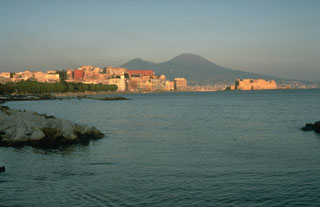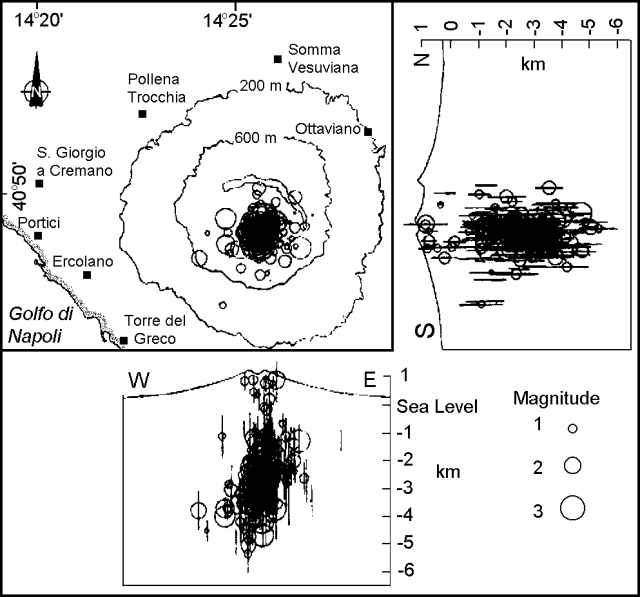Report on Vesuvius (Italy) — June 1996
Bulletin of the Global Volcanism Network, vol. 21, no. 6 (June 1996)
Managing Editor: Richard Wunderman.
Vesuvius (Italy) Seismicity during 1995-96 is the highest in the past 50 years
Please cite this report as:
Global Volcanism Program, 1996. Report on Vesuvius (Italy) (Wunderman, R., ed.). Bulletin of the Global Volcanism Network, 21:6. Smithsonian Institution. https://doi.org/10.5479/si.GVP.BGVN199606-211020
Vesuvius
Italy
40.821°N, 14.426°E; summit elev. 1281 m
All times are local (unless otherwise noted)
The Somma-Vesuvius volcanic complex is a central composite volcano formed by an older stratovolcano (Monte Somma) with a summit caldera partially filled by the composite cone of Vesuvius. The most noted eruption, in 79 A.D., destroyed the ancient cities of Pompeii and Herculaneum. Since the explosive sub-Plinian eruption of 1631, Vesuvius has erupted with both Strombolian and mixed effusive-explosive styles. For the past three centuries the volcanic activity has mainly focused inside the Somma caldera but occasionally lava issued outside it (i.e., 1760 eruption). The last cycle of activity ended with the 1944 eruption. Since then, the volcano has been characterized by moderate seismicity and intra-crater fumarolic activity.
The Osservatorio Vesuviano maintains an array of short-period seismographs (eight three-component and nine vertical-component instruments). Seismicity was monitored during 1995 and March-April 1996. The 1995-96 period was the most active of the past fifty years. Several hundred microearthqukes (M < 3.2) were recorded during 1995, many from sources within the volcanic edifice above sea level. An increase in strain release and in frequency of earthquakes was observed from August to October 1995. During this period 217 events were recorded. Three of these earthquakes had M > 3.0 and were felt by the local population (~600,000 people): the first event (M 3.1, focal depth 3.1 km) occurred on 2 August; the second (M 3.2, focal depth 4.2 km) on 16 September, and the third (M 3.1, focal depth 3.3 km) on 24 September.
During November 1995-February 1996 the seismicity decreased to less than 10 events/month, and the strongest earthquake was M 2.5. During March-April 1996, however, 296 earthquakes were recorded. A M 3.4 event at 2 km depth was the strongest recorded during the past fifty years. Seismic activity at Vesuvius decreased again after this event.
Hypocenter locations for the past two years have clustered in a small volume below the crater area, no deeper than 6 km below sea level (figure 1). Focal mechanisms of relevant events suggested that the cause of seismicity was crustal rupture. Harmonic tremor and monochromatic low-frequency events were not observed. No changes in ground deformation or fumarolic gas compositions were reported.
A Reuters news story noted that a geophysical experiment is planned at the end of June to obtain a tomographic image of the volcano. The report said that the experiment, a joint-venture of Swiss, French, and Italian scientists, includes a series of controlled explosions at 14 boreholes on the volcano's slopes and as far away as the Sorrento peninsula. The explosions will be monitored by a network of 250 seismic stations. In addition, a marine seismic prospecting survey will be carried out in the Bay of Naples to investigate the volcano's submarine flanks.
Geological Summary. One of the world's most noted volcanoes, Vesuvius (Vesuvio) forms a dramatic backdrop to the Bay of Naples. The active cone was constructed within a large caldera of the older Monte Somma edifice, thought to have formed incrementally beginning about 17,000 years ago. The Monte Somma caldera wall has channeled lava flows and pyroclastic flows primarily to the south and west. Eight major explosive eruptions have taken place in the last 17,000 years, often accompanied by large pyroclastic flows and surges, such as during the 79 CE Pompeii eruption. Intermittent eruptions since 79 CE were followed by a period of frequent long-term explosive and effusive eruptions between 1631 and 1944. The large 1631 eruption produced pyroclastic flows that reached as far as the coast and caused great destruction. Many towns are located on the flanks, and several million people live within areas that could be affected by eruptions.
Information Contacts: Lucia Civetta, Francesca Bianco, Giuseppe Vilardo, and Mario Castellano, Osservatorio Vesuviano, Via Manzoni 249, 80123 Napoli, Italy; Paul Holmes, Reuters News Service.


